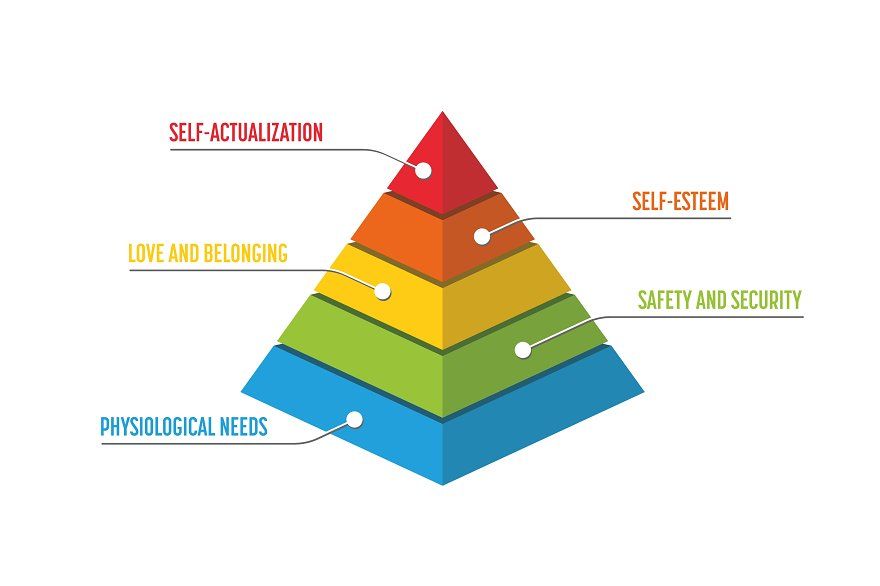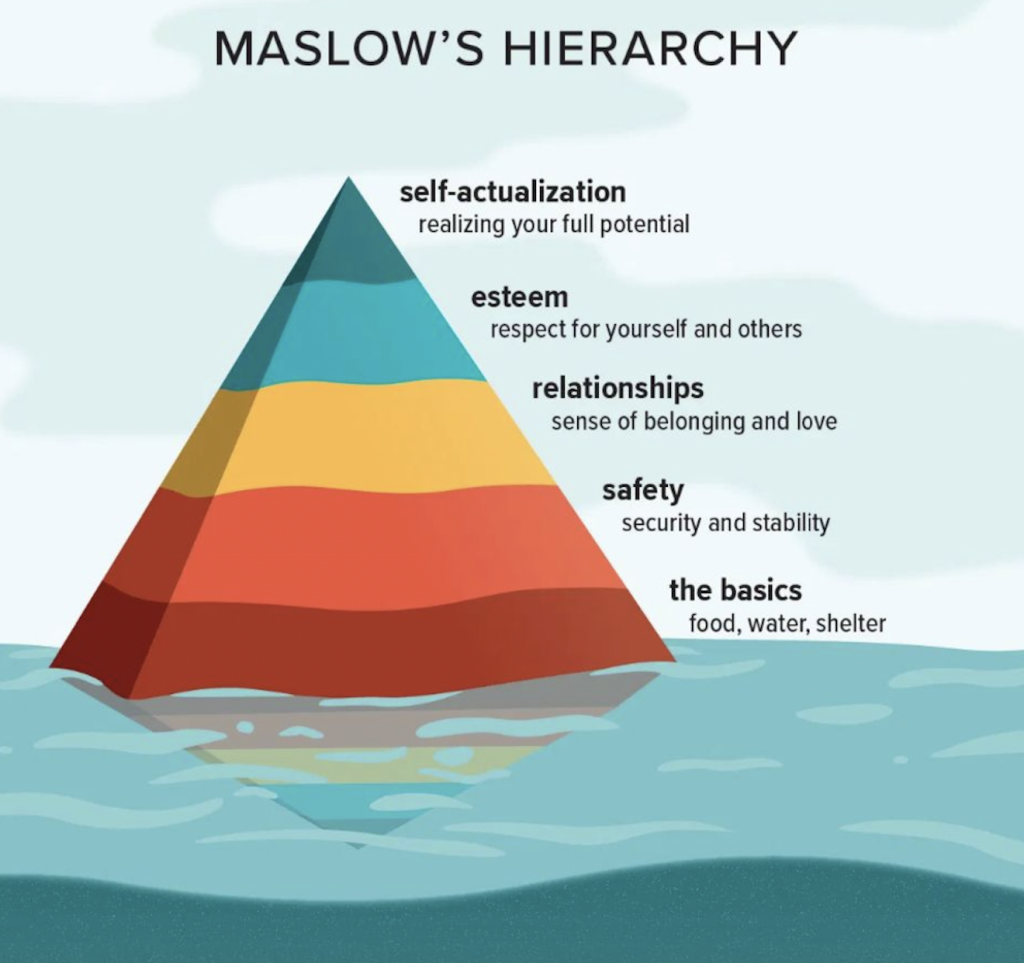In the world of self-actualisation or self-development, there are plenty of motivational tools to help you achieve your goals. You’ve probably seen dozens out there with even the most basic of online searches.
In this blog, we walk you through an important resource. We’re looking at a seminal model in the field of motivational psychology – Maslow’s pyramid of needs. We are considering Maslow’s model in the context of self-development and upskilling so you can stay motivated and grow as a person and as a professional.
If you’re new to motivational psychology, you’ll benefit from an overview of a tool for your self-improvement.

Or, if you’re a seasoned student of psychology, you’ll benefit from a practical application of Maslow’s tool to better understand your motivations and help you lead a fulfilling life at home and at work.
What is the pyramid of needs?
The Maslow pyramid was first presented in 1943 by Abraham H. Maslow. The theory is suggests that human behaviour is driven by a series of goals. Maslow presented five levels of needs, later organised into the shape of a pyramid. Each level represents a stage of your basic needs and how you fulfil them.
The hierarchy suggests a sequential relationship between all the needs. Generally, you must fulfil your most basic needs before you move on to fulfilling higher ones.

Even without much background about the model, the stages will probably make sense and look familiar to you.
Stages
Here are the five stages, from the lowest to the highest.
- Physiological: These are the most basic biological requirements like food and water.
- Safety: You want to feel safe and live in a predictable world. That is why you get a job and buy or rent a home to call your own. It’s why you live in a society where you enjoy laws, social practices and public services.
- Belongingness and love: You need interpersonal relationships including friendships, romance and trust. You can also desire to be affiliated with a group. For example your peers, colleagues or a professional association.
- Esteem: In the fourth level, you strive to fulfil a desire to have independence or create a reputation for yourself.
- Self-actualisation: At the highest level of the pyramid. You are motivated by growth and new experiences on your path toward self-fulfilment.
It all looks very tidy and organised while laid out in five easy steps. However, human behaviour is complex and we are often influenced by multiple needs at the same time.
There are also roadblocks that you’ll run into on your path to fulfilling your needs. As you move up the hierarchy, disruptions might cause you to delay, stop or revert your progress completely.

For example, a divorce might harm your fulfilment in stage three (belongingness) of the pyramid. More than that, a divorce can cause instability in your career life, leading to a feeling of unrest at work. It might lead to a lack of on-the-job performance that threatens your job security, which further impacts your second need (security).
While everyone has the potential to reach the highest stage on the pyramid, it’s important to understand that fluctuations and disruptions occur in your life that cause you to move back and forth between meeting your different types of needs.
Motivation within the pyramid
In the first four levels, your actions are motivated based on an absence of fulfilment for your needs. Think of it this way – if you’re hungry, you’ll find some food to eat. Or, if you’re lonely, you’ll seek out a sense of belonging through social interactions.
It only gets more complicated as you meet your needs and move higher up in the hierarchy. For instance, satisfying level four (respect and esteem) can be a complex process. It’s a common association at the workplace, where you crave an appreciation and respect for your hard work.
It’s a good thing, therefore, to understand your needs and what drives them. If you are not certain what these are, a close friend or a life coach can help you identify what your needs are and what motivates you.

In the fifth stage, something interesting happens to your motivations. Once all your basic needs are met, you are moving to a self-actualisation stage. Your motivations are no longer fueled from an absence of something but from a desire for growth. You’ll start to engage in life-fulfilling behaviour to grow as a person.
What is self-actualisation?
On the self-actualisation level, your actions are motivated by a desire to reach your personal potential. Maslow viewed self-actualisation as a continuous process. It’s not something to achieve and then pack up and put away. Once you start to grow as a person, it’s a lifelong journey – kind of like upskilling and personal development.
Once your basic needs are met you can devote yourself to what’s known as a state of ‘becoming’. You continually grow, learn and upskill while simultaneously finding meaning in your life.

To get a visual for what self-actualisation looks like, consider your own career path. If you work at a company, you’ll strive to become a valuable employee. You might develop new skills, work with a job coach or set goals.
What encourages this behaviour? The answer is unique to different individuals, but if you’re in a self-actualised state you generally grow as an employee to improve your satisfaction with your own performance and life. You don’t build cross-departmental relationships because it makes it easier to get things done, but because those professional relationships bring you happiness and fulfilment.
Transcendence of needs – a new model
Some adjustments have been made to the Maslow model over the years. Some stages were added to the pyramid as part of its own improvement process,
One of the most significant adjustments is the recognition of a stage of transcendence. This is a spiritual need to expand your viewpoints and see beyond your own individual well-being.

It might sound like a religious experience, but it’s not restricted to religious thinking. Transcendence can include lots of other behaviours such as the enjoyment of nature, the provision of service to others or making commitments to virtually any cause that inspires you.
It’s a fitting addition to the model that accounts for the complex emotions and motivators for our actions. A perfect example is a career changer who feels a vocational calling. Their motivations might extend from a passion for a new field of study that transcends their previous work experience.
What we can learn from Maslow today?
Maslow’s model, despite its age, still has some fitting applications to today’s world.
At the workplace, it can be a useful model to understand your company’s actions and your own behaviour. A company might develop a corporate culture to help employees feel welcome and have a sense of belonging. You guessed it – that company is fulfilling its employees’ needs in the third stage of Maslow’s hierarchy.

Or, at the highest levels of the pyramid, the need for transcendence and the importance of one’s actions can be a powerful motivator for social action and corporate responsibility. The need to feel connected to others or part of something greater might inspire people and corporations to fight climate change, poverty or another cause that’s important to them.
Maslow’s model is a versatile resource in your toolkit to optimise your mindset and understand your motivations. Larger than that, it can explain what brings people together as a global community to work on solutions to some of the biggest issues of our times.
Book a 15-minute free discovery call with one of our life coaches today to help identify what motivates you.











